Patch management is one of the most effective, yet overlooked cybersecurity practices to keep your operations safe. And it’s not just me saying it, statistics do too.
For example, were you aware that 80% of cyberattacks happen due to unpatched vulnerabilities? With 84% of companies and online businesses reporting suffering at least one cyberattack in the past year, I say it should concern you.
But with so many different solutions on the market, how can you make the most of patch management? Which solution offers the right balance? This is what I will explain to you in this article.
The Best MSP Patch Management Software on the Market
Here are the top five patch management software for MSPs in 2024:
- Heimdal® for Streamlined MSP Patch Management
- ManageEngine Vulnerability Management Plus for Centralized Control
- NinjaOne for Simplified IT Operations
- Automox for Cloud-Native Patch Management
- Action1 for Cloud-Based Patch Deployment
1. Heimdal® Patch & Asset Management
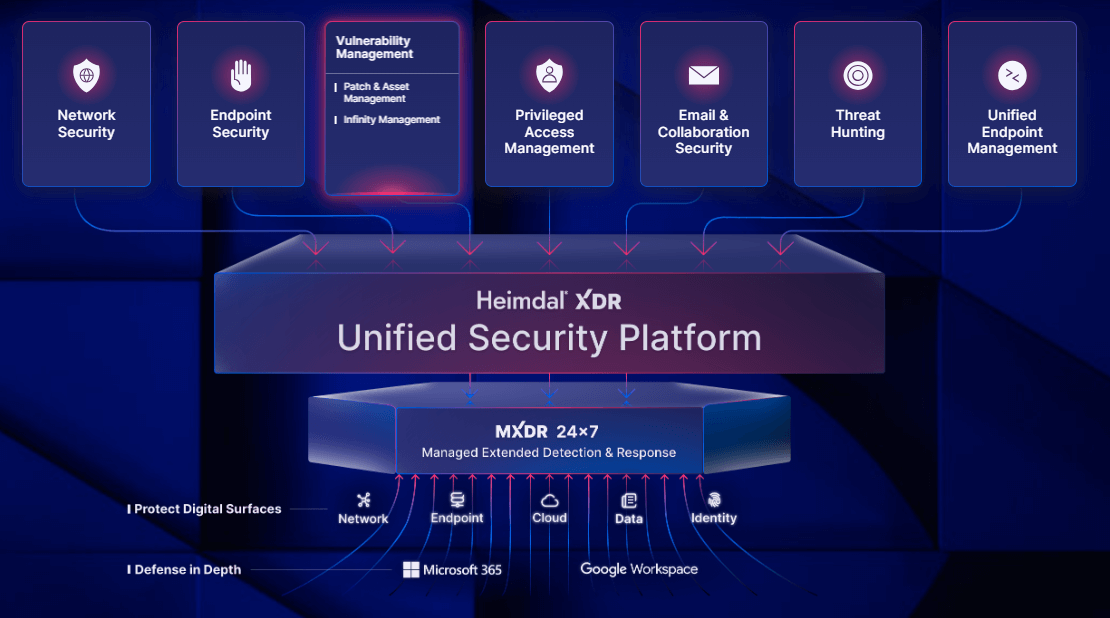
Heimdal® Patch & Asset Management is the go-to solution for MSPs seeking seamless patch management. Heimdal® is designed just for MSPs. It makes patching easy for all your clients from one central place.
With Heimdal®, you can automatically update software on all main operating systems like Windows, macOS, Linux, and furthermore, it also patches third-party apps and even proprietary apps.
Heimdal® will also make sure you will not be stressing about being compliant with industry regulations like GDPR, Cyber Essentials, CIS18, NIS2, and more, as compliance is guaranteed.
What sets Heimdal® apart is its customization options. It empowers you with full control over scheduling and deployment, including custom or hands-free setups and policies that won’t disrupt end-users, whether they’re onsite, hybrid, or globally distributed
Also, the Infinity Management add-on makes automation even easier. It helps you organize tasks for specific client applications without any hassle. By using Heimdal® effectively, MSPs can provide outstanding service, keeping clients’ systems and reputation safe.
Heimdal® Pros:
- Heimdal® offers comprehensive patch management for multiple clients, streamlining MSP operations.
- Automation of patch deployment saves time and reduces manual effort.
- Ensures compliance with industry regulations, enhancing security and trust.
- Customizable scheduling minimizes disruptions for clients.
- Supports a wide range of third-party applications for comprehensive protection.
- Swift patch delivery, typically within 4 hours, keeps systems secure.
- Easy enforcement of patching policies across all client systems.
- Infinity Management add-on enables further automation for client-specific applications.
The Heimdal platform contains many different components. We are only subscribed to the two that currently fit our business needs: Patch & Asset Management, and Remote Desktop. The former is a superb tool for automated patching of operating systems and 3rd party software, plus contains a tool to deploy custom scripts and applications – very versatile.
Heimdal® Cons:
- Learning curve for new users may require time to master.
- Dependency on stable internet connection for effective operation.
The solution is so secure that when I forget the master password I struggle to break into my own system. I had a few struggles with support when I started using the product but all were resolved as I got better acquainted with the solution.
Heimdal® Pricing:
Heimdal® offers custom pricing based on your needs. Get in touch with us, book a demo, and one of our representatives will take care of you and discuss all the details.
We use Patch Management, E-mail Security and Remote Desktop modules from the Heimdal® portfolio. All these products run through a single agent and consistently perform well. We push Microsoft patches every month to clients and servers without issue (and more reliably than something like WSUS) , Remote Desktop is simple to use as an admin, just right-click the agent search for the user you want to connect to and go, and E-mail Security Spam filtering catches the majority of the bad things. Heimdal® also creates a decent asset register for each device you install the agent on. Support is also responsive and helpful, normally coming back with an answer in only 30 minutes!
Heimdal® User Review from G2 (Source)
2. ManageEngine Vulnerability Management Plus
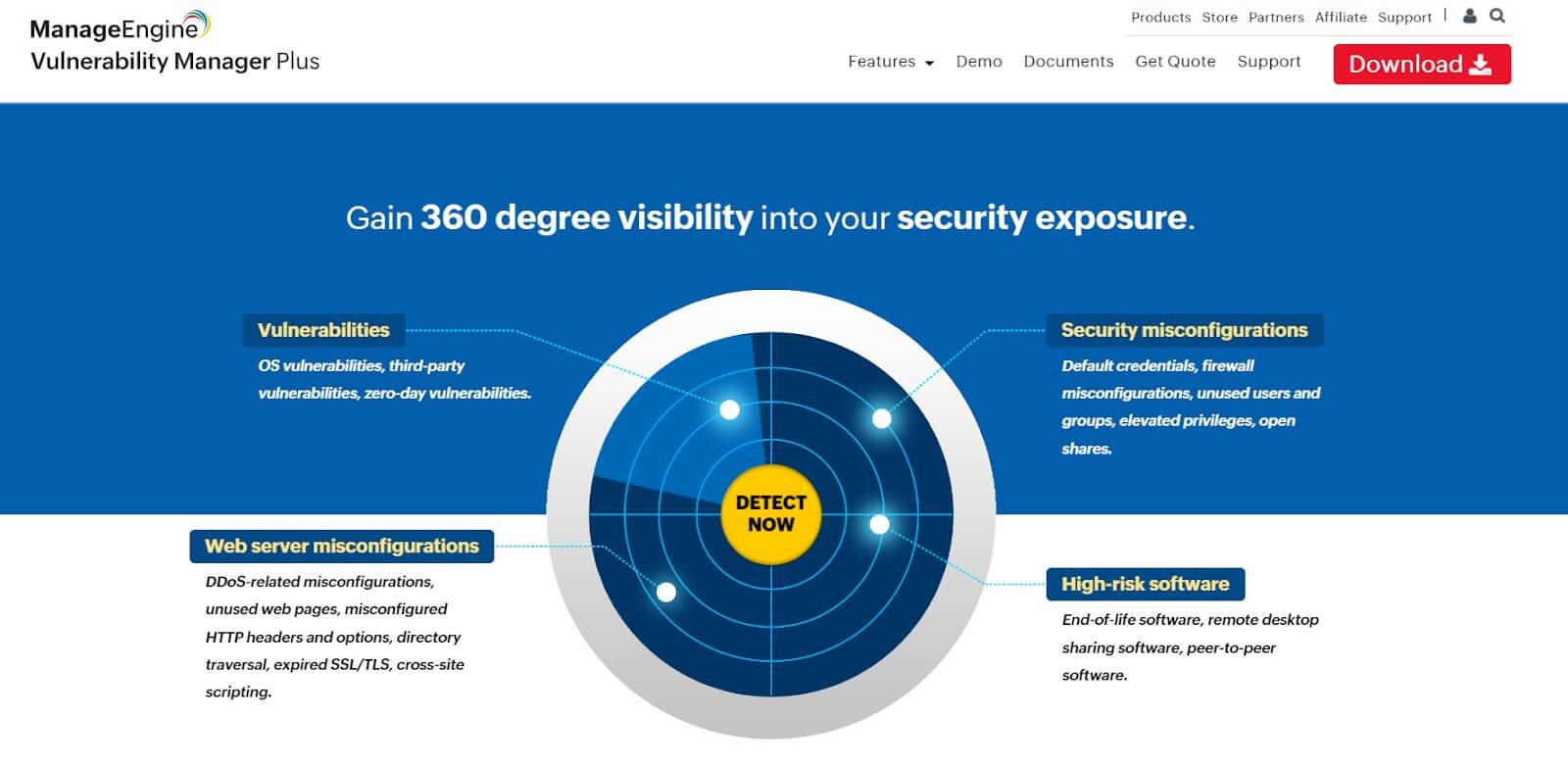
ManageEngine Vulnerability Management Plus makes patching easy by bringing all the tasks into one place, perfect for organizations with different types of networks.
It helps IT pros manage patches across different systems efficiently while keeping everything secure and compliant.
One great thing about it is its automatic patching, which saves time and effort. It also scans networks thoroughly to find and fix security issues. Plus, it supports lots of different operating systems and software, so it’s useful in many situations.
ManageEngine Patch Management Plus Pros:
- ManageEngine Patch Management Plus offers comprehensive centralized control.
- Supports a variety of operating systems.
- Provides detailed vulnerability assessments.
The ManageEngine platform has a very intuitive UI, very helpful support staff, and an extremely competitive price point price.
ManageEngine Patch Management Plus Cons:

- Requires a minimum 10-seat purchase.
- Has a steeper learning curve.
- Offers limited third-party integrations.
Support and account servicing always misunderstand what you’re trying to explain, not proactive in providing technical product support. The account manager will promise the sky but forgets to deliver after that.
ManageEngine Patch Management Plus Pricing:
Starting from $34/user/month.
ManageEngine Patch Manager Plus is a very simple product to set up and use. We are testing it out with about 20 systems and so far it is working very well. We had just been using WSUS previously and we were finding that a lot of systems were not getting updated, especially if they were not on the network for long periods of time. PMP takes care of that and updates the systems no matter where they are. It also handles many 3rd party apps as well as hardware updates like drivers and system firmware. We plan to roll this out to the entire organization.
ManageEngine Vulnerability Management Plus User Review on G2 (Source)
3. NinjaOne (Formerly NinjaRMM)
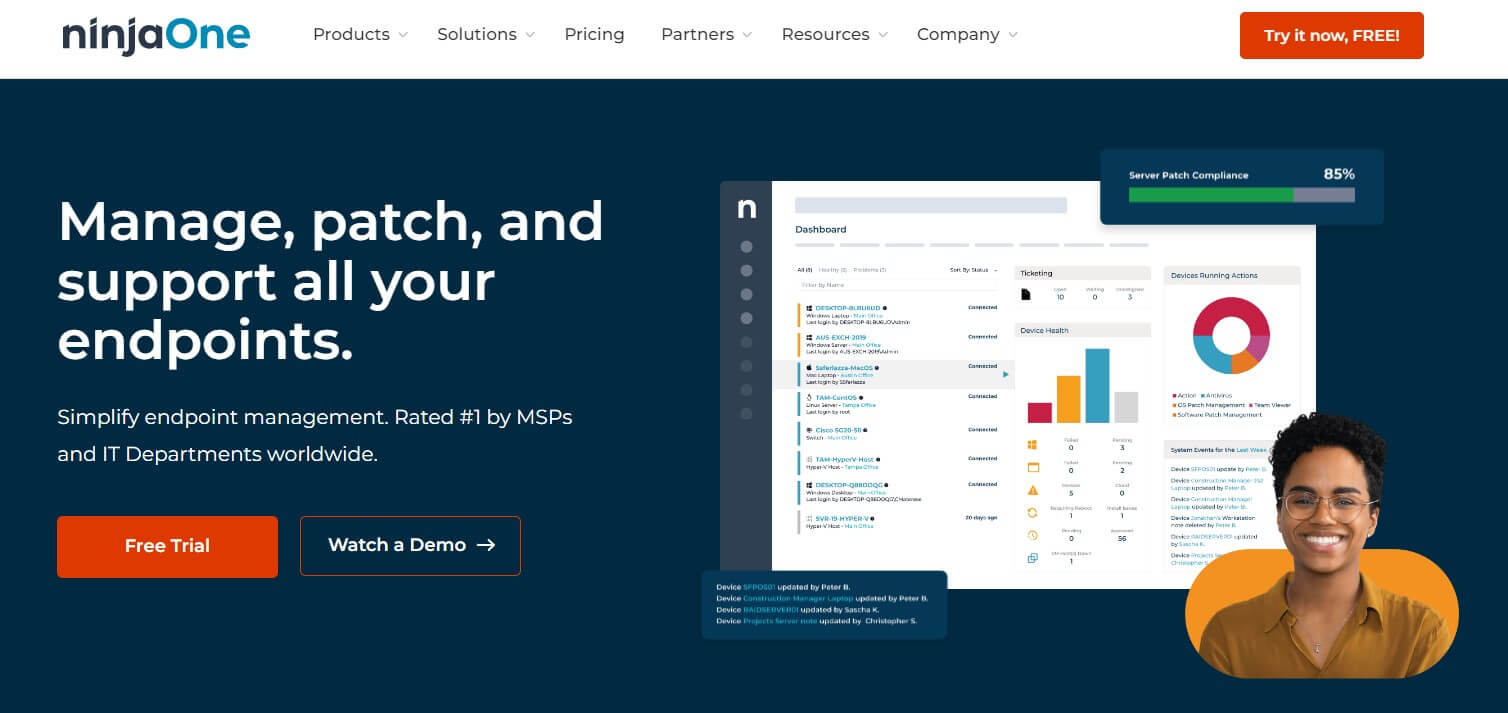
NinjaOne is an all-in-one IT operations solution that makes managing patches and reporting compliance easy, especially for organizations with specific reporting needs.
It’s known for its simple and user-friendly patch compliance reporting, which is great for organizations that need clear and straightforward reports.
NinjaOne has useful features like automatic patching, custom scripting, and real-time monitoring. Its dashboards are easy to understand and help with compliance reporting.
Plus, it works well with other popular IT tools and cloud storage services like Dropbox and Google Drive, so it fits right into your existing setup.
NinjaOne Pros:

- NinjaOne’s automation capability transforms internal IT departments into highly efficient operations.
- The platform provides comprehensive insights into assets, networks, and activities, enabling proactive management.
- Integrated ticketing and documentation modules streamline IT processes, serving as a one-stop hub.
What I like best about ninja is The interface is clean, modern, and fast. It’s the fastest and most modern around. No other RMM is more modern or fast. We use it everyday to manage our customer environments and since it’s so modern and fast, it is a joy to use.
NinjaOne Cons:
- Occasional service disruptions to regional instances may occur, but with no significant outages reported.
- The platform’s learning curve for new users might require time to adapt.
- Dependency on a stable internet connection may affect effective operation.
Sometimes when I am connecting to a machine with a high resolution. It is hard to see everything because it is so tiny. The only way to fix this is to change the user’s settings. There is a chance you will forget to change it back and the client will be upset. It would be nice if the size would change automatically when connecting.
NinjaOne Pricing:
Starting from $3/user/month.
I like the fact that the software is easy to use. It is also easy to add devices to the app. I like that they are adding features. I use this everyday all day. I like the fact that you can integrate other apps to NinjaOne so that you have a single pane of glass to access everything you need.
NinjaOne Review on G2 (Source)
4. Automox
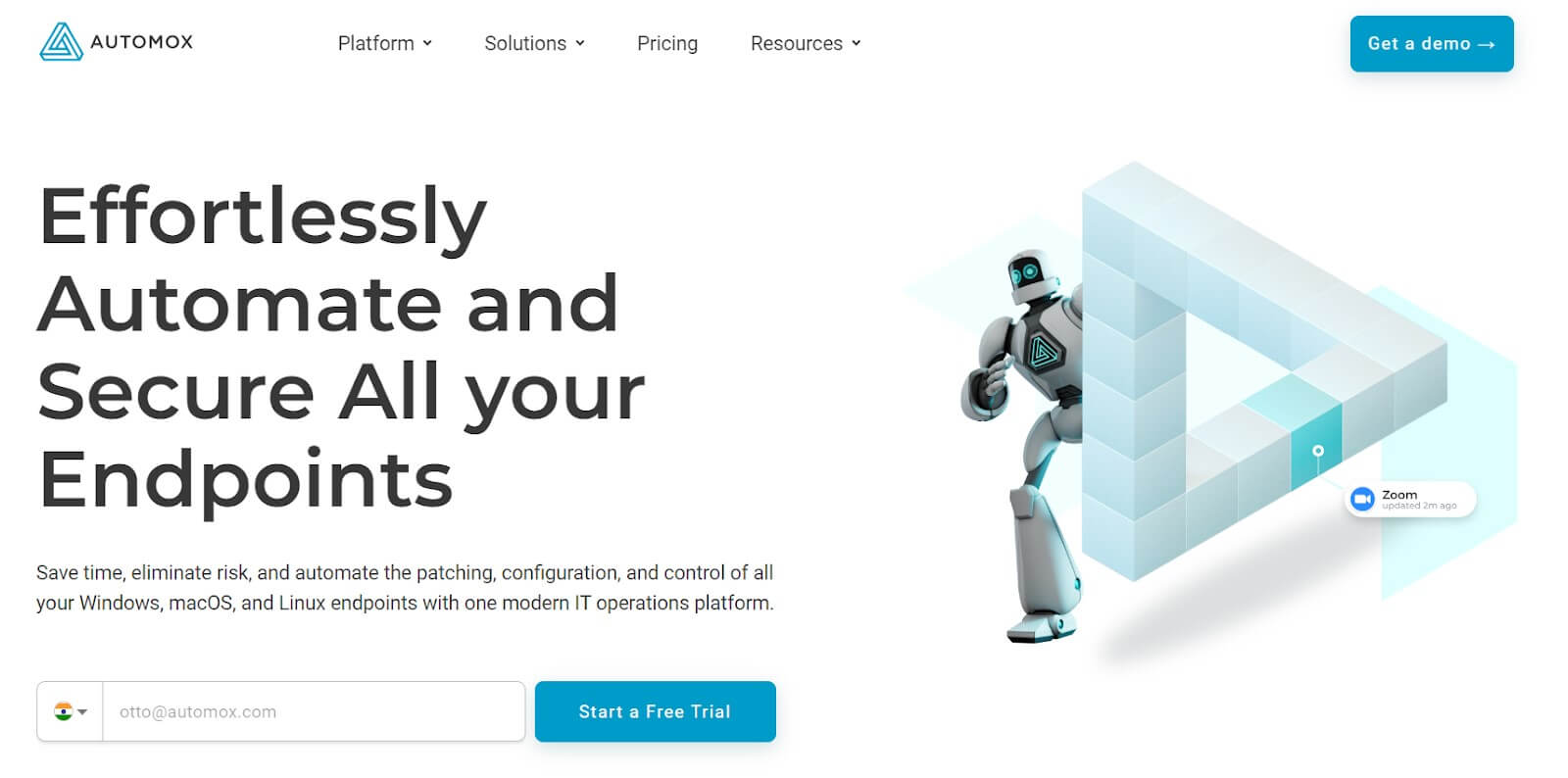
Automox handles patch management in the cloud, covering everything from finding updates to installing them, which is great for keeping remote devices safe. It’s flexible and can grow with your organization, especially if you work a lot in the cloud.
Automox it’s built for cloud systems and does a thorough job of patching, which is crucial when so many people are working remotely. It’s especially good at handling remote devices or cloud setups.
Automox is known for automatically finding your systems, regularly checking for vulnerabilities, and following policies to keep everything up to date. This makes patching easier and lowers the chances of security problems.
Plus, it works well with other popular tools like Slack, Jira, and Webhooks, which helps keep everyone in the loop.
Automox Pros:
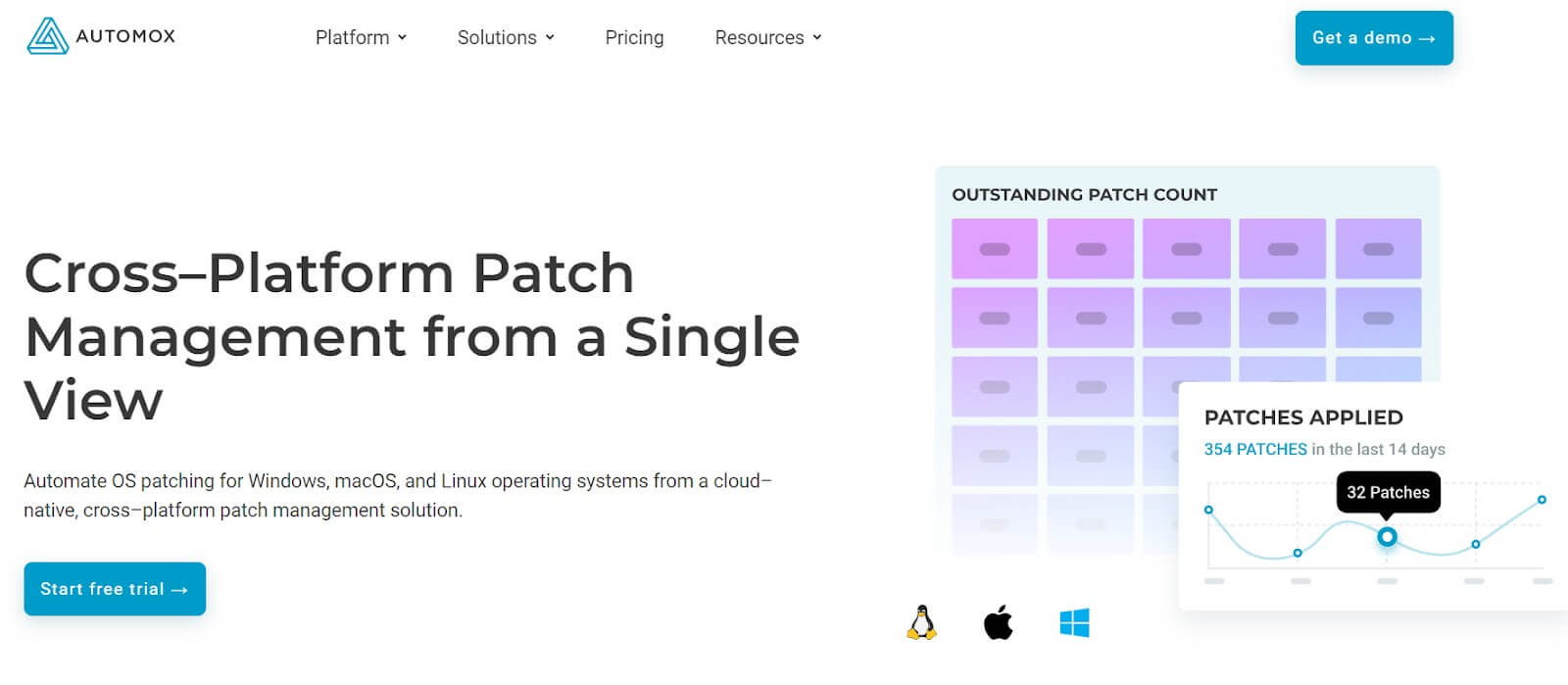
- Tailored for contemporary, dispersed organizations, being a cloud-native platform.
- Implements policy-based automation, simplifying patch management duties.
- Seamless integration with commonly used third-party tools enhances communication and collaboration.
Automox is simple and easy to use and the worklets library is an amazing place to find pre-built commands. We were easily able to identify and update 150 Windows 10 machines to the latest build overnight which was a nightmare for us before on our old system.
Automox Cons:
- May not be the optimal choice for organizations not entirely cloud-centric in their operations.
- Annual pricing models may not align with the preferences of certain businesses.
- Setup and configuration demand a high degree of technical proficiency.
I dislike that I can’t simply pick the days of the given months for patching. I have to choose by the month and week. But, for instance, If I want to patch every 4th week of every month, if there is a day that is on it’s 4th iteration that month, but not a part of the 4th full week of that month, the patching starts earlier than expected, so you have to setup a second patch schedule to handle split weeks.
Automox Pricing:
Starting from $3/user/month.
Automox is really great with the patching process. We’ve created several policies for different items. We have a policy that automatically updates web browsers and selects 3rd party software.
Automox Review on G2 (Source)
5. Action1
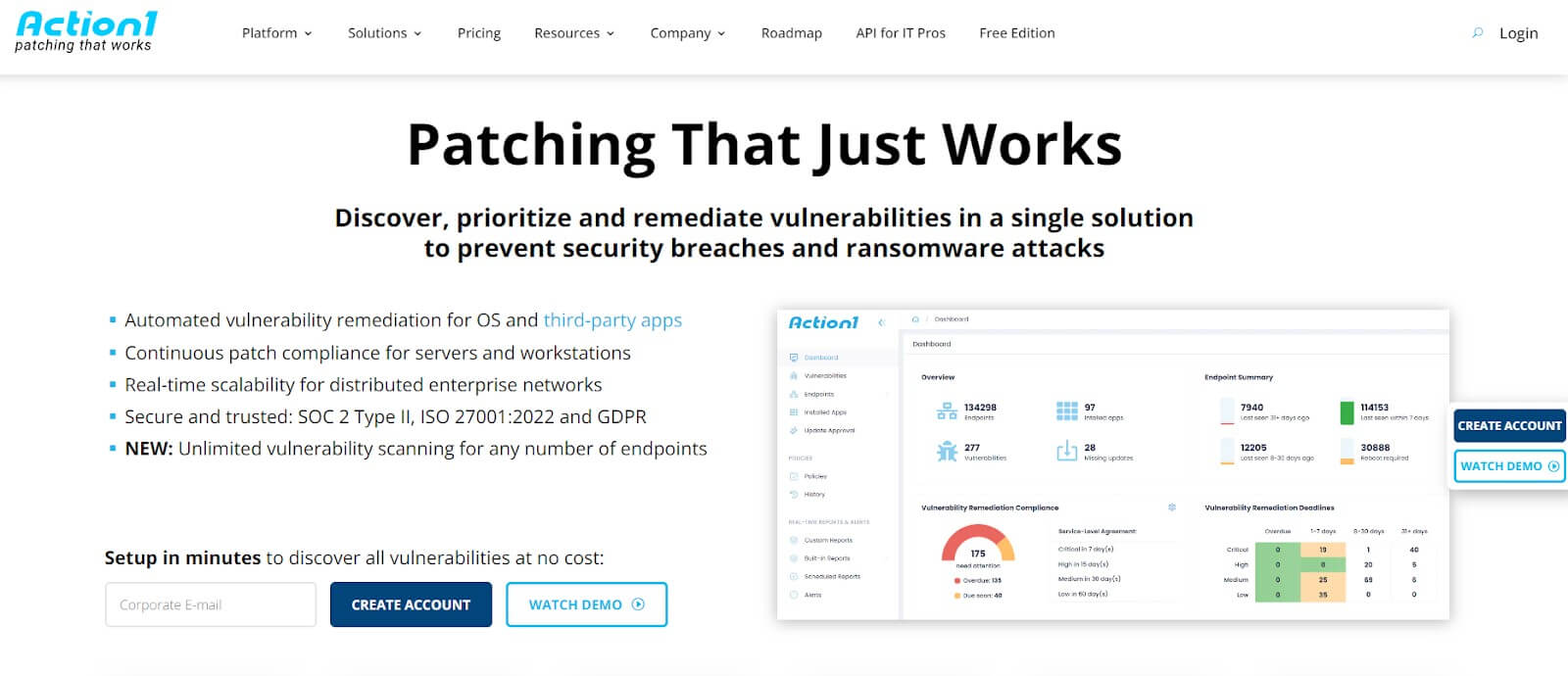
Action1 is a cloud-based solution designed to automate patch deployment for remote teams, which is great for companies with employees spread out in different locations.
I chose Action1 because it’s cloud-based, which means it’s really good at handling patches for remote workers. It ensures everyone gets the updates they need, no matter where they are. This is especially important for companies with lots of remote employees.
Action1 stands out because it automatically checks for patches, gives real-time reports, and works on different systems, so it’s flexible for businesses with various operating systems. Plus, it works well with popular systems like Active Directory and SCCM, so it fits right into your existing setup.
Action1 Pros:
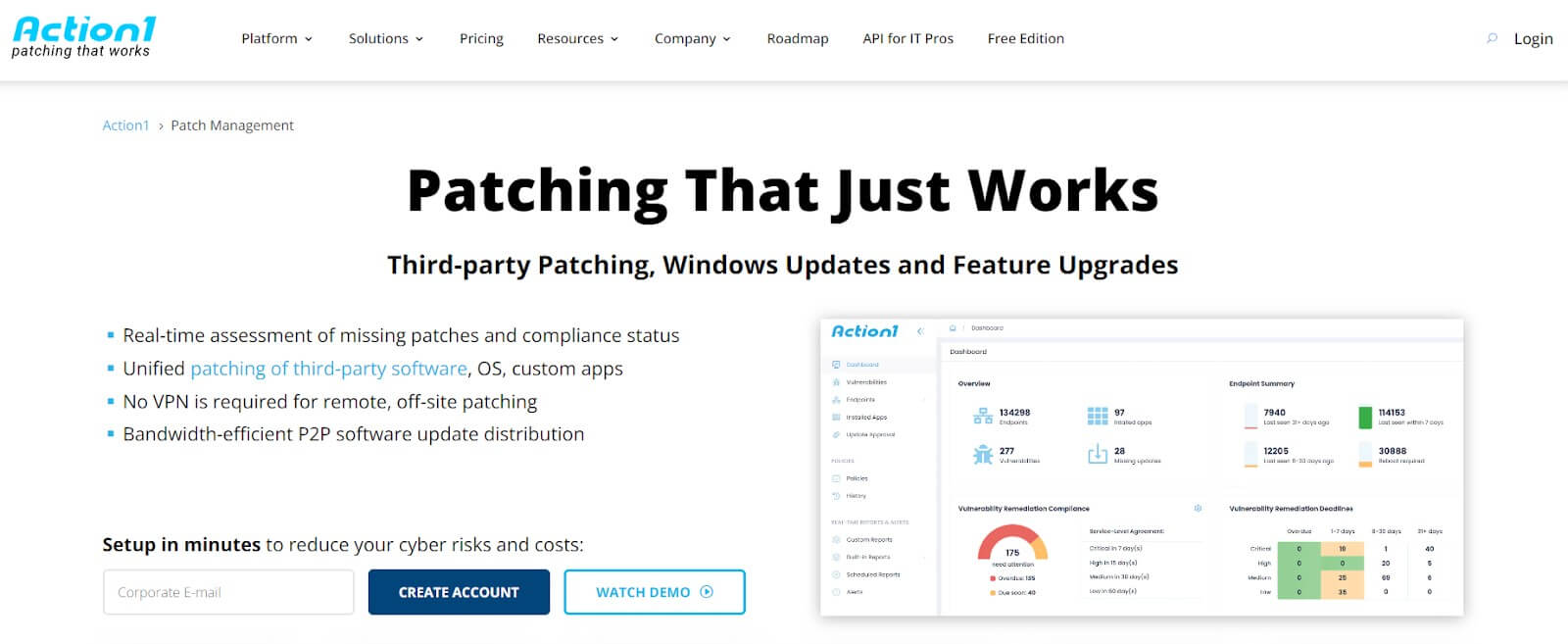
- Optimized for remote workforce management with its cloud-based architecture.
- Real-time reporting offers instant visibility into patch compliance status.
- Comprehensive multi-platform support caters to various operating systems.
Easy to install, they provide a free account so you can really test the tool. Action 1 is a fantastic tool in that it will update all your user’s machines with no distractions for the users.
Action1 Cons:
- Minimum seat requirements may not align with the needs of smaller organizations.
- Potential learning curve for teams unfamiliar with patch management processes.
- Limited feature set compared to certain enterprise-level solutions.
Reporting, vulnerability management, and remote desktop; remote desktop has heavy lag in lots of my environments. In contrast RealVNC, and AnyDesk have run flawlessly. Reporting does not allow you to customize critical columns, and vulnerability reports are next to useless, mainly because it reports based on perceived issues rather than actual versioning. I have no idea what they are doing over there, but it is improving.
Action1 Pricing:
Starting from $10/user/month
The Action1 team is responsive to customer inquiries and developing sought-after features. The remote viewer capability works well and meets my basic needs. I’m still working away at the patch management but it appears to be sufficient.
Action1 Review on G2 (Source)
The Buying Guide: What to Consider When Choosing the Perfect MSP Patch Management Software?
When it comes to selecting the ideal patch management solution, there are several crucial factors to consider. Here’s a concise breakdown to help you make the right choice:
1. Automation
Opt for a solution that automates patching processes to save time and reduce manual errors. Automation ensures timely updates without the need for constant supervision.
2. Remote Accessibility
Look for a platform that offers 24/7 access from anywhere, enabling you to manage patches remotely and respond promptly to emerging threats, even when you’re on the go.
3. Custom Policy Implementation
Choose a solution that allows you to implement custom patching policies tailored to your organization’s specific needs and compliance requirements. Flexibility in policy creation ensures optimal security posture.
4. Device Control
Ensure the solution provides granular control over which devices to patch, allowing you to prioritize critical systems and avoid disruptions to essential operations.
5. Cross-Platform Compatibility
Check that the solution supports patching for a diverse range of operating systems, including Windows, Linux and macOS. This ensures protection across your entire IT infrastructure.
6. Scalability
Consider the scalability possibilities of the solution to accommodate future growth and evolving business needs. A scalable patch management solution can adapt seamlessly to changes in your organization’s size and complexity.
7. Security Features
Assess the security features offered by the solution, such as vulnerability assessments, threat intelligence integration, and patch validation mechanisms. Robust security measures enhance protection against cyber threats and minimize the risk of breaches.
8. Reporting and Analytics
Evaluate the reporting and analytics capabilities of the solution, which provide insights into patching activities, compliance status, and potential vulnerabilities. Comprehensive reporting enables informed decision-making and proactive risk management.
By prioritizing these aspects, you can be confident that the remaining patch management solutions offer the best mix of efficiency, flexibility, and security.
Making the right choice today will keep you safe from tomorrow’s threats.
The Risks of Choosing the Wrong Patch Management Software
Although it might not seem that complicated to choose a patching solution, keep in mind that choosing the wrong patch management software, one that does not suit your needs, can in time impact your business operations, reputation, and much more.
Want to know what’s at risk? Here’s a breakdown for you:
Increased Vulnerabilities and Security Breaches
Between 2021 and 2023, data breaches rose by 72%, surpassing the previous record. A patch management solution that’s not up to par can leave you wide open to cyberattacks and breaches. Shockingly, more than half of security breaches happen because a vulnerability wasn’t patched.
These vulnerabilities give hackers a way into your systems, letting them access important data and cause serious damage.
Compliance Violations and Legal Consequences
Poor patching also leads to compliance issues with industry regulations and data protection laws.
And so, your MSP could face legal repercussions, including fines and lawsuits.
Operational Disruptions and Downtime
Poor patching practices are a leading cause in disruptions and system downtime.
Loss of Competitive Edge and Client Trust
As an MSP, your reputation for providing reliable and secure services is important. Choosing the wrong patch management solution can damage this reputation, leading to client dissatisfaction and potential loss of business to competitors.
Financial Costs and Resource Drain
Preventing is always better than treating. Studies show that the average cost of a data breach globally is $4.45 million, an all-time high. You definitely don’t want to deal with such fixing costs.
And this is not even taking into consideration the resources used in dealing with the aftermath of a data breach. Be cautious and choose the patch management solution that guarantees your safety best.
Reputational Damage and Brand Erosion
A security breach or compliance slip-up can really hurt an MSP’s reputation. Bad press and lost trust from clients and stakeholders can damage your brand, making it hard to recover credibility in the market.
Missed Business Opportunities
A damaged reputation and lost trust can lead to missed chances and trouble attracting new clients. People might think twice about working with an MSP known for security problems or compliance slip-ups.
Want to know some real horror stories of what improper patching practices led to? Check these out:
- Reddit Breached: Threat Actors Steal Source Code and Internal Data
- T-Mobile API Data Breach Affects 37 Million Customers
Both scenarios show how important it is to manage patches properly. They led to big financial losses, harm to reputations, and lost trust from customers. MSPs need to learn from these stories and make sure they have strong patch management systems in place to protect their businesses and clients from cyber threats.
Start Patching The Right Way: Best Practices + Our Cheatsheet
Patching means updating software to fix problems and make it more secure. It’s super important for keeping your organization safe from hackers who love to exploit vulnerabilities in outdated systems.
Here’s how to do it right:
- Make a Patching Plan: Write down how you’ll find, test, and install patches. This keeps things clear and consistent.
- Check for Vulnerabilities: Scan your systems regularly to find weak spots. Then, fix the most urgent ones first.
- Focus on Critical Fixes: Not all patches are urgent, but some are. Start with the ones that protect against serious threats.
- Test Patches First: Before updating all your systems, try out patches in a safe place to avoid any surprises.
- Stick to a Schedule: Set regular times to update, so you’re always on top of it without causing chaos.
- Use Automation: Tools that automate patching save time and effort, making life easier.
- Keep an Eye on Compliance: Make sure all your systems are up to date and following the rules.
- Educate Your Team: Teach your staff why patching matters and how to do it right.
To kickstart your patching journey, grab our free patch management template/cheatsheet. It’s packed with practical advice to help you patch like a pro and keep your organization secure. Download it now and get patching.
Heimdal® — The Unified Security Platform Suited for MSPs
Heimdal® is trusted by Managed Service Providers worldwide for its complete cybersecurity toolkit. Explore our award-winning solutions suited for MSPs.
Heimdal® has the world’s widest cybersecurity platform, featuring products for:
and more! If you’re offering cybersecurity as one of your managed services, Heimdal® empowers you with everything you need to succeed!
Join Our Partner Program: Partner NEXUS
Heimdal® is now closer than ever thanks to our initiative tailored for MSPs, MSSPs, distributors and resellers: Partner NEXUS.
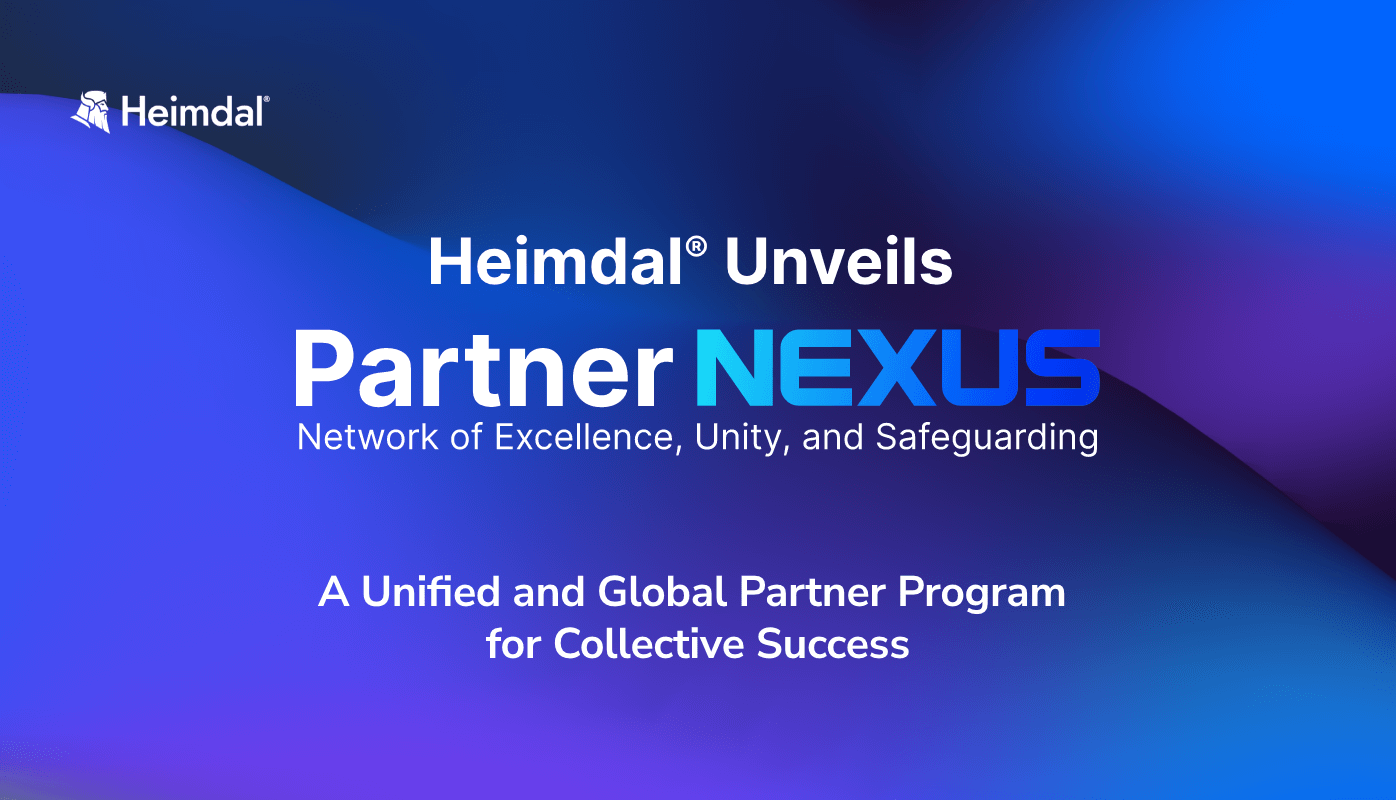
Through our program, we aim at improving customer security and expanding business opportunities.
Why to join in? As an MSP, MSSP, distributor or reseller, you gain access to a comprehensive cybersecurity kit, user-friendly platform that simplifies security management, and extensive training and support for you to focus on growth and turn the tide against cyberattacks. Moreover, you get the best in cybersecurity:
- The most extensive XDR suite in the market.
- Unified management for simplified control.
- Next-level threat intelligence.
- Reliable and efficient cloud-native architecture.
- Innovative telemetry and responsive capabilities.
- Managed SOC services with exceptional support.
Conclusions
Get ahead with our 2024 MSP patch management guide. It’s packed with tips and tools to boost your system’s security. Whether you’re a pro or just starting out, our guide covers top software choices and important factors for picking the best solution.
Plus, our template makes patch management a breeze, helping you protect your clients’ systems like a pro.
Frequently Asked Questions (FAQ)
What is MSP patch management?
MSP patch management refers to the process by which Managed Service Providers (MSPs) oversee and administer software updates, commonly known as patches, across the IT infrastructure of their clients.
This includes identifying available patches for various software applications and operating systems, testing them for compatibility and reliability, deploying approved patches to client systems, and ensuring that all devices are up to date with the latest security and performance updates.
What does patch management software do?
Patch management software automates the process of identifying, testing, and deploying software updates, ensuring systems are up to date with the latest security patches and minimizing manual effort. It prioritizes patches based on severity, tests them for compatibility, and monitors systems for new updates, helping organizations maintain compliance and enhance cybersecurity.
Why do we need patch management?
Patch management is essential for maintaining the security and stability of computer systems by promptly applying software updates and security patches to address vulnerabilities and protect against cyber threats.







